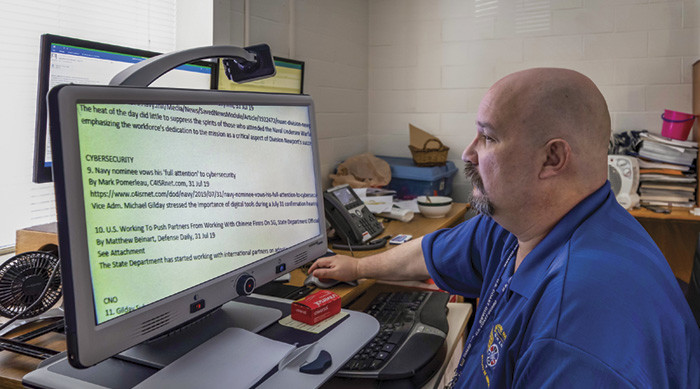John Tebo, who works at the Naval Undersea Warfare Center, uses a special device to help him read text and do his job. Photography by Nathanael T. Miller/Naval Undersea Warfare Center Division
If someone needs an item that hasn’t been acquired in the past, both the DRC and CAP’s staff will investigate what options exist to help identify which product would be ideal.
“If the person has reduced vision — maybe someone has cataracts or a detached retina and blurriness — there are software programs for screen reading that will allow you to enlarge text or information on the screen,” Young says. “Or, you can have emails read in applications aloud.”
DOD agencies and their partners work with a designated disability program manager who can help facilitate the tech acquisition process, according to Young. Other agencies may also be tapped as a resource when CAP is trying to track down a new piece of technology.
“It’s very likely not the first time someone in the federal government has asked for it,” Young says. “The IT department at agency X may not have seen that item, but the IT departments at agencies C and Y could have vetted it.”
READ MORE: Explore the considerations IT teams must deal with as they strive to meet modern accessibility standards.
Agencies Search for Newer and Safer Technologies
In general, new hardware tends to be viewed as less of a security concern, according to Young.
“I would say 95 percent of what we provide are plug-and-play USB items — just like if you have a Dell computer, the keyboard that came with it is what you’d plug into the USB port, and the driver would be recognized,” he says. “Nothing really new on the keyboard is going to be installed on the computer, which implies they are pretty safe.”
CAP’s goal is to try to deliver a blanket list and more bespoke accommodations to the intended recipient within 30 days of when approval and all documentation is received. Security-related testing “would extend the timeline, because vetting is not an immediate, very quick process,” says Young.
Considering applications to be compromised until proven otherwise can be a less risky position for agencies to take, according to Chase Cunningham, principal analyst at Forrester.
“Much like other tech items, what’s been developed to help people with disabilities is able to be an avenue of exploitation,” Cunningham says. “Because the computer that received the software is networked, it quickly becomes a larger issue.”
CAP can sometimes speed the fulfillment process up somewhat by identifying an alternative version of the software that’s ready for immediate use, Young says.
“If the 2020 version is not yet vetted or allowed on the network, we might be able to find a 2018 version that’s allowed,” he says. “It’s pretty atypical that if a person has an issue causing them difficulty accessing computers, we can’t find something that will work.”













